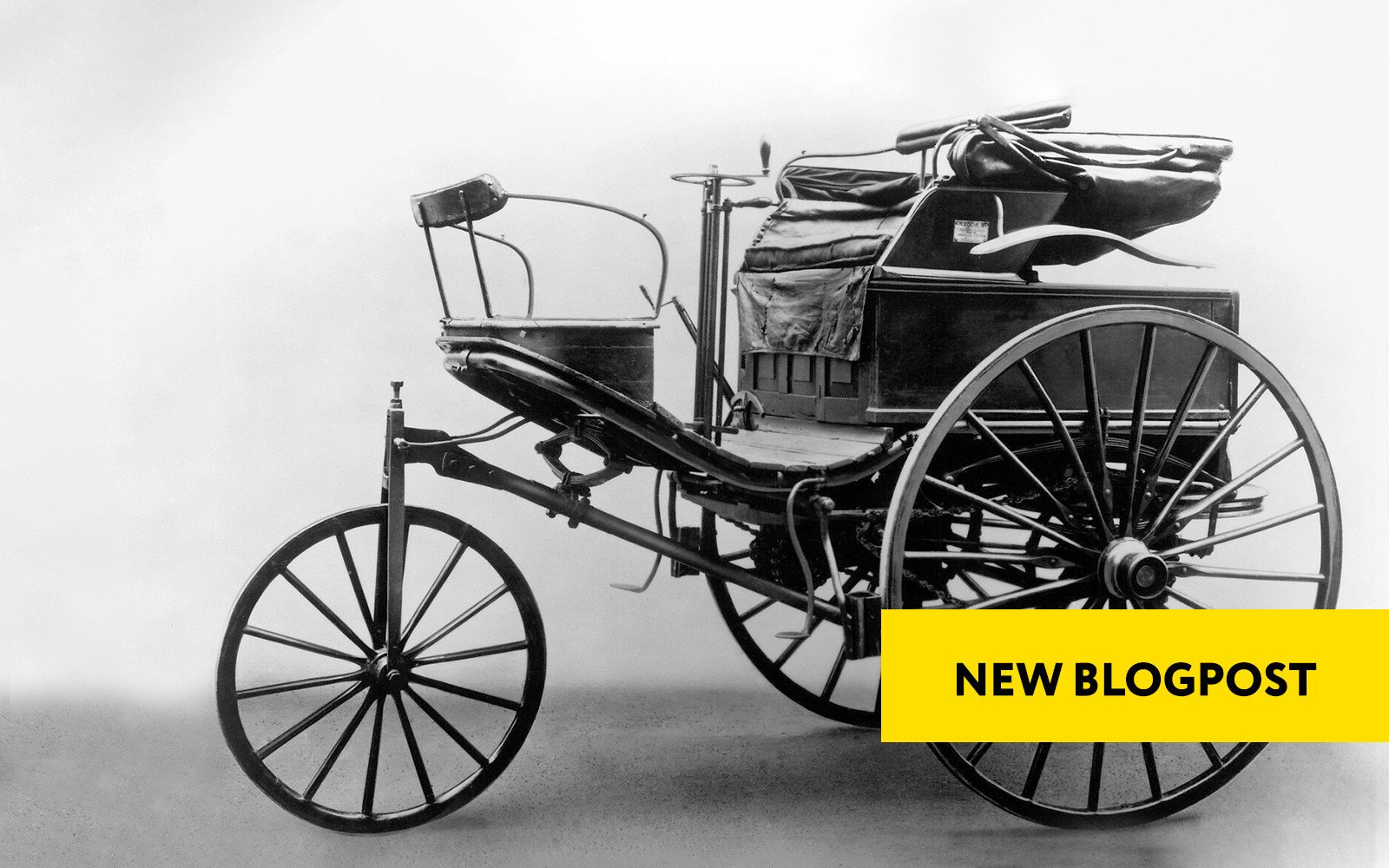
AUTOMOTIVE DIAGNOSTICS – A BRIEF HISTORY IN HOWEVER MANY CHAPTERS
In its current format the Abrites Blog was started on October 1st 2021 and we talk about different topics related to Abrites products and diagnostics in general. The problem is that we have not laid the foundation of what automotive diagnostics actually is. In my opinion, this is a fascinating branch of the automotive industry in general and it is worth spending some time learning about. So let’s dive right in.
I. Genesis.
Ever since a vehicular apparatus set wheel on the road they have been braking down. This lead to the need for people who had the mindset to be able to repair them. I believe the first of our colleagues to do so was named Karl Benz and the first time a car was diagnosed was in 1885 when Benz patented and drove his Motorwagen though I presume he used tools far different to the sophisticated computer machines of today. History has also told us the story of Benz’s wife – Bertha who by all accounts had to have been the first independent diagnostician, as she was the first to drive the Motorwagen cross country with her sons Richard and Eugen back in 1888 where I am sure they must have encountered the need to troubleshoot an issue with Benz’s creation. I am just speculating but it seems plausible that our profession has been practiced for more than 137 years.

II. Evolution to revolution.
As the Motor car progressed we find various tools relating to diagnosing issues with vehicles. There were stethoscopes, wrenches, needles, screwdrivers – you name it. All rudimentary tools from the times when the vehicles in need of diagnosing were just as simple. But humans are just not built to stand still, we wanted more, we wanted to evolve and as technology in all aspects moved forward from the Industrial era so did the Motorcar. By the 20s and 30s of the 20th Century the car was becoming a more complex machine, but a purely mechanical one. This was a beautiful time for design with the outstanding Art-Deco Bugatti Aerolithe, Atlantic, etc. The Bentley Blower and Mercedes SSK 540 to name a few. All moving pieces of art which stopped everyone in their tracks when they saw them out in the wild. All purely mechanical pieces of perfection with presence beyond the scope of what was, and still is conceivable. And then World War II broke out and the evolution was stopped dead in its tracks because all of the artisans behind these masterpieces were forced to start making ugly, reliable killing machines. Such tragedy.
Thankfully, after the war ended in 1945 what was left of these geniuses continued with the same passion and even though their resources were nowhere near what they were before, we started moving forward.
1. First steps towards digitizing the automobile.
It wasn’t until 1968 when the first on-board computer system was introduced with one of the pioneers of the fuel injection in the form of the Volkswagen type 3. The system installed in that car did not have any diagnostics but I am mentioning it because it was the first to pave the way forward. Bosch and Bendix were heavily involved and Electronic Fuel Injection slowly started taking over the carburetor throughout the 1970s and 1980s.
It was somewhere in 1975 or 1976 depending on the sources you trust that Kent Moore introduced what we can refer to as the first factory diagnostic tool. Perhaps the first modern EFI vehicle to be diagnosed was the Datsun 280Z.


2. One small step for diagnostic, one giant leap for diagnostics kind.
So it began, more efficient EFI engines were popping up left and right, everyone was making more efficient, more precise engines, Motorsports were getting involved and the pace with which our evolution was moving looked more like a revolution. We had more power than ever, more fuel economy and the pace we were moving with was unstoppable.
Every car company had their own development in EFI, this required diagnostic tools and, of course everyone had an opinion on how to go about that. Every car company had their own diagnostic connector in their vehicles and they all used a different diagnostic tool to connect through it.
We then passed through the BLINK CODE era where you would leave the car in the ACC position and count the amount of times a light would blink to indicate what was wrong.
General Motors are credited with creating the very first of the On-Board Diagnostic connectors with the ALDL (Assembly Line Diagnostic or Data Link).
This is now referred to as OBD of the very first generation. A few other honorable mentions here most be made with the Mercedes 38 pin connector (which we still use a lot to this day as it was installed in vehicles all the way up to 1999), BMW 16 pin connector, etc.

3. A cool example of what you can do when money is no option in the diagnostic world is the Mclaren F1 and the tools they used for the diagnostic of this car – each Mclaren F1 came with its own diagnostic interface and laptop to which the guys at Woking could connect remotely to your car and determine the issues it has. Read more about it HERE.


What a baller move to show to your other wealthy friends – “Well, you see, Richard, it doesn’t just have actual gold lining in the engine bay, it comes with its own computer.”
III. Modern era. OBD2
Welcome, everyone who made it this far to 1996.

For music fans around the globe 1996 will be remembered as the year the world lost one of our greatest poets – Tupac Shakur who took his last breath on September 13 of that year. RIP.
In the automotive industry, however it had come time to put some order in the diagnostics. Things were really getting out of hand, because every company had at least one diagnostic port to communicate by, they only worked with the company’s proprietary tool and nothing else. On top of that there were very few trained professionals who could translate what the machines said. It was mayhem and in the land of the blind the one eyed were kings. It was time to put an end to all that. The Americans spear-headed this change by introducing the standardized ON BOARD DIAGNOSTIC connector, second generation or OBD2. This event relied a lot on the “Right to repair act” and to automotive specialists was the best thing since sliced bread. Slowly but sure the whole world started coming along because it was just better to have a unified system, kind of like Esperanto, but working. In modern vehicles the electronic units have a network where they communicate not just to the diagnostic tool but to each other, as well 2001 saw the European countries enforcing EOBD, In Japan they had the JOBD and so on but they all utilized the same protocols:
- KWP 2000 or Key Word Protocol
- CAN or Control Area Network
- UDS or Unified Diagnostic Service
These are the three main ones used today and they of course evolve all the time but in case you are interested you can read more on which one does what and how later on. I will do a deep study of the protocols in the future so that we have better knowledge but this is a story for another time. Our focus today is history, and why? Well for the same reason everyone else does -history usually teaches us lessons for the future and keeps our memory in check. We want to see where we go but I just want to take you back to 2005 in Sofia, Bulgaria when my favorite diagnostic tool was created – the AVDI and Abrites Diagnostic Software. It all started much like EFI in 1968 with Volkswagen and it grew to the universal multi functional tool most of our readers have today.

IV. What does the future hold?
As Doris Day once said – Que sera sera. In other words, nobody knows and nobody has credibly returned to tell us but here are my 2 cents on the matter.
Modern cars often have 50-100 modules in every vehicle 10s of kilometers of wires. New companies are emerging left and right, they are not as anchored by history as the current automotive giants and they are the ones leading the way forward with a minimalist approach – less wires, less modules, unification, standardization, ease of installation and you might think it is just cost driven. I am not so cynical and I believe they are also doing that for the “greater good” or at least they have people, engineers there with this mindset. Now, I think this is the principle direction but to be more precise I believe that in the next 10-15 years there will probably be almost no wiring in new cars, perhaps just optical and power. Modules will probably communicate in an Over The Air (OTA) network and they will probably be connected to the manufacturers via constant internet access.
I also believe that we are going to go through a bit of a turbulent time when we transition to whatever comes after OBD2 but it will be short and not so painful because we have regulations and regulating bodies in place on all continents. But what about the tools – this is what is most interesting to me. I believe most diagnostic tools will have access to remote diagnostics and customers will probably know what their car needs even before going to the workshop. You know where I am going with this – lower costs, quicker repair times – you can order the parts and have them delivered by drone before the car even comes to you. Sounds good to me but we still have a lot of work to do until then so until we meet again next week – Picture me rollin’, my friends.
Alek
 TCU Personalization Without FBS4 Data
TCU Personalization Without FBS4 Data
 BDC2 Replacement and Mileage Reset for BMW
BDC2 Replacement and Mileage Reset for BMW